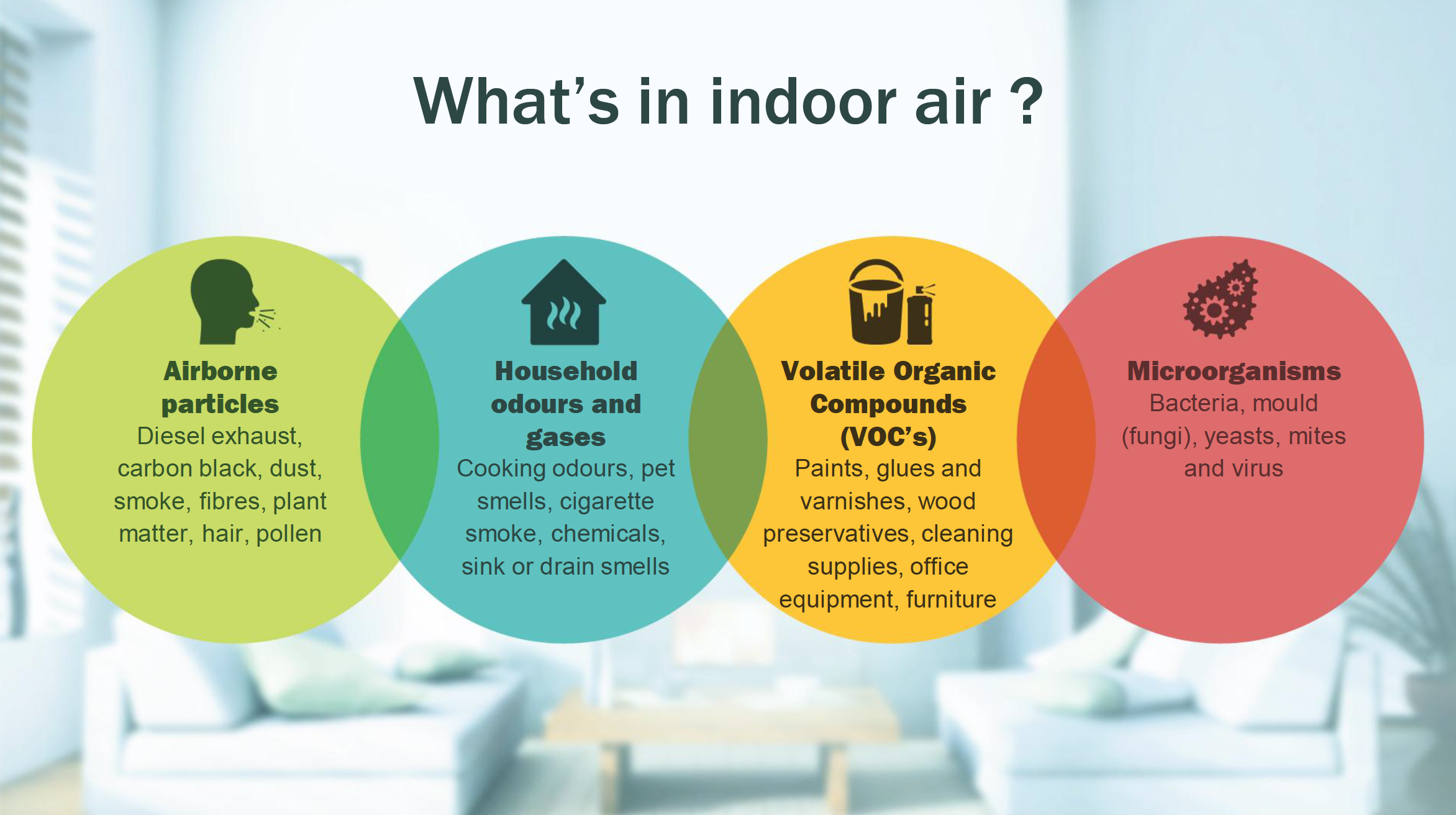Indoor air quality plays a crucial role in our overall health and well-being, yet it often goes unnoticed until its effects manifest in noticeable symptoms. Poor indoor air quality can lead to a variety of health issues, from fatigue and respiratory problems to decreased cognitive function and productivity. In fact, studies indicate that factors such as indoor air pollution and inadequate air ventilation can significantly impact workplace air quality, affecting the health of employees in office environments. With the rise of healthy buildings initiatives, improving air quality has become a priority for creating spaces that promote wellness and productivity. Addressing the factors that contribute to indoor air quality is essential not only for individual health but also for fostering a thriving workplace and community.
The environment we inhabit indoors, often referred to as indoor environments, can significantly influence our health and productivity. Terms like air quality in buildings, indoor environmental quality, and ventilation dynamics encompass the broader implications of these spaces on our well-being. With growing concerns over indoor pollutants and their effects, finding ways to enhance ventilation and reduce contaminants is becoming critical. This shift is integral to the modern concept of creating healthy buildings that prioritize occupant health and comfort. By focusing on air health and quality, we can foster environments conducive to better mental and physical wellness.
Understanding Indoor Air Quality and Its Health Impact
Indoor air quality is a crucial yet often overlooked aspect of our daily lives, significantly influencing our overall health and wellness. Many Americans spend approximately 90% of their time indoors, whether at work, home, or school, making the air quality in these environments critical. Poor indoor air quality can lead to a range of health issues, from short-term symptoms like fatigue and difficulty concentrating to long-term consequences such as respiratory diseases and reduced cognitive functionality. Addressing these challenges requires an understanding of how pollutants and allergens accumulate indoors, often exacerbated by inadequate air ventilation.
In a study conducted by Harvard researchers, findings revealed that simple improvements in building air ventilation can enhance cognitive function among workers significantly. Enhancing airflow reduces the concentration of indoor air pollutants, including volatile organic compounds (VOCs) and particulate matter, leading to healthier working conditions. By prioritizing air quality management through better ventilation practices and air filtration systems, workplaces can not only protect the health of employees but also boost productivity.
The Dangers of Indoor Air Pollution
Indoor air pollution is a pressing concern that affects millions. Sources of pollution can range from common household items like cleaning products and scented candles to outdoor air infiltration, which carries pollutants indoors, compromising air quality. According to studies, individuals working in environments with elevated levels of indoor air pollution display higher rates of absenteeism, lower productivity, and increased health complaints. These factors illustrate the urgent need for renovations and policy changes that prioritize healthier building practices.
With the current understanding of how toxic substances can linger in indoor spaces, organizations are encouraged to act. Implementing strict guidelines for the use of chemical products and increasing the frequency of maintenance checks for HVAC systems are just two strategies that can diminish indoor air pollution. This proactive approach not only protects health but also demonstrates a commitment to creating sustainable and healthy environments.
Ways to Improve Indoor Air Quality
Improving indoor air quality can be both a straightforward and beneficial endeavor. Traditional improvements often include enhancing ventilation systems, allowing more outdoor air to circulate into indoor spaces, thus diluting indoor pollutants. Additionally, utilizing high-efficiency particulate air (HEPA) filters in air purifiers can significantly help in filtering out harmful particles, thereby promoting a healthier indoor environment.
Moreover, adopting a greening approach, such as incorporating houseplants that can naturally purify air, may also enhance the aesthetic quality of the space while contributing to better air quality. The synergy of mechanical ventilation and nature can create a balanced approach that benefits both physical and psychological health, especially in workplaces that seek to enhance worker satisfaction and productivity.
Healthy Buildings and Their Importance
The concept of healthy buildings goes beyond mere aesthetics and structural integrity; it encapsulates the fundamental role that environmental factors play in occupant health. Buildings designed with health in mind prioritize aspects such as natural light, air quality, and acoustics, thus creating environments conducive to wellness. The rise of the healthy buildings movement underscores the need for architecturally sound strategies that meet safety and wellbeing standards.
Healthy buildings are particularly essential in workplaces, as employees are likely to spend a significant part of their day within these confines. Research indicates that when indoor environments are optimized for health, overall job satisfaction, retention rates, and productivity levels noticeably improve. Investing in healthy buildings is not only integral for public health but also beneficial for businesses aiming to foster a more engaged and motivated workforce.
Air Ventilation and Health: The Connection
The relationship between air ventilation and health is key in understanding indoor air quality. Proper ventilation systems help to reduce humidity, remove indoor air pollutants, and ensure that fresh air circulates throughout a space. Inadequate ventilation can lead to a buildup of harmful substances, increasing the risk of respiratory issues, allergies, and other health complications. By ensuring sufficient air changes per hour (ACH) in buildings, occupants can significantly reduce their exposure to indoor pollutants.
Recent studies have demonstrated a direct link between improved ventilation rates and increased employee performance in workplaces. Enhanced air circulation not only reduces the concentration of harmful particles but also promotes a sense of comfort and security among occupants. This makes air ventilation a critical factor in designing healthy and productive indoor environments that prioritize occupant wellbeing.
Workplace Air Quality: A Critical Focus
Workplace air quality is paramount to employee health and productivity. With many people spending upwards of eight hours a day in office environments, the potential repercussions of poor air quality cannot be overstated. Factors such as dust, mold, and chemical pollutants can lead to what’s referred to as ‘sick building syndrome,’ where employees experience various health issues as a direct result of their indoor environment. Thus, it is crucial for employers to assess and improve air quality within their facilities.
Employers can ensure high workplace air quality by conducting regular audits and implementing air quality management strategies. Initiatives may include increasing ventilation, using air purification systems, and adopting environmentally friendly materials in construction and furnishings. By identifying and mitigating sources of indoor air pollution, businesses not only fulfill their duty to protect employee health but also enhance overall workplace satisfaction and engagement.
The Impact of Outdoor Air Pollution on Indoor Spaces
While we may think of outdoor air pollution as separate from our indoor environments, the reality is that they are intricately linked. Influences such as urbanization and industrial emissions significantly impact the quality of air that infiltrates our homes, schools, and workplaces. High levels of particulate matter from outdoor sources can lead to a need for improved filtration systems indoors, especially in urban areas where pollution is prevalent.
Understanding the dynamic interplay between outdoor and indoor air quality highlights the importance of proactive environmental strategies. Implementing measures to mitigate outdoor air contaminants, such as creating green buffers around buildings or using advanced air filtration systems, can protect indoor air quality from external pollutants. This holistic approach is essential for minimizing harmful health effects and fostering environments that support optimal physical and mental health.
Conclusion: Prioritizing Indoor Air Quality for Better Health
In conclusion, prioritizing indoor air quality is essential for safeguarding health and enhancing well-being in the spaces we inhabit. Understanding the nuances of indoor air pollution and the benefits of healthy building designs empowers individuals and organizations to take actionable steps towards creating better environments. By combining improved ventilation, advanced filtration, and a commitment to green practices, we can significantly enhance our living and working conditions.
As awareness of the importance of healthy spaces grows, it becomes increasingly vital for stakeholders — from policymakers to business leaders — to prioritize indoor air quality standards and strategies in their planning. This not only contributes to individual health and productivity but also fosters broader public health initiatives that aim for a healthier society overall.
Frequently Asked Questions
What are the effects of indoor air quality on health?
Indoor air quality (IAQ) significantly affects health, influencing respiratory issues, allergies, and overall well-being. Poor indoor air quality can lead to symptoms like fatigue, headaches, and even cognitive impairments, emphasizing the need for maintaining a healthy environment.
How does air ventilation and health relate to workplace air quality?
Air ventilation plays a vital role in workplace air quality by ensuring the circulation of fresh air while removing pollutants. Improved air ventilation has been shown to boost cognitive function and reduce sick leave, thereby creating healthier workplaces.
What is indoor air pollution and its impact on healthy buildings?
Indoor air pollution includes harmful substances like volatile organic compounds (VOCs), dust, and allergens that accumulate in buildings. This pollution can hinder the creation of healthy buildings by compromising occupant health and comfort.
How can improving indoor air quality benefit cognitive function in workplaces?
Research shows that enhancing indoor air quality through better ventilation and reducing pollutants can significantly improve cognitive function, allowing employees to focus better and enhance productivity.
What are some common sources of indoor air pollution in homes and workplaces?
Common sources of indoor air pollution include tobacco smoke, mold, household cleaning products, and building materials. Identifying and mitigating these sources is essential for improving indoor air quality and promoting health.
Why is it important to monitor indoor air quality in healthy buildings?
Monitoring indoor air quality is crucial as it helps detect pollutants and ensure a healthy environment. Regular assessments can lead to significant health benefits and improved productivity in healthy buildings.
What steps can be taken to reduce indoor air pollution in a workplace?
To reduce indoor air pollution, workplaces can increase ventilation, implement regular cleaning protocols, use air purifiers with HEPA filters, and minimize the use of VOC-emitting products.
How does outdoor air quality influence indoor air quality?
Outdoor air quality directly impacts indoor air quality as pollutants can enter buildings through openings, ventilation systems, and directly from outdoor activities, highlighting the need for effective air filtration and ventilation practices.
What is the connection between sick building syndrome and indoor air quality?
Sick building syndrome occurs when occupants experience health effects linked to time spent in a building with poor indoor air quality. Symptoms include headaches, dizziness, and respiratory issues, all of which can be alleviated by improving IAQ.
What role does humidity play in indoor air quality?
Humidity levels directly influence indoor air quality. High humidity can promote mold growth and dust mites, while low humidity can lead to dry skin and respiratory discomfort. Maintaining optimal humidity levels is essential for a healthy indoor environment.
| Key Point | Details |
|---|---|
| Indoor Time | Americans spend about 80% of their lives indoors. |
| Cognitive Function | Increased air ventilation in workplaces has been shown to improve cognitive function. |
| Air Ventilation Rates | Shifts in air ventilation rates since the 1970s aimed to reduce complaints, not solely for health benefits. |
| Indoor Air Pollution | Indoor spaces can contain more outdoor air pollution than one might realize. |
| Air from Neighbors | In an apartment setting, up to 30% of indoor air can come from neighboring units. |
| Healthier Buildings | Identifying opportunities to improve indoor air quality can lead to healthier buildings. |
| Air Quality and Disease | Bringing in outdoor air and using filtration can reduce disease spread indoors. |
| Dust Composition | Dust can contain hormonally active substances, affecting health. |
| Chemical Regulations | Only about 6 of over 80,000 chemicals available for commerce have been banned by the EPA since 1976. |
Summary
Indoor air quality is crucial for maintaining good health and productivity. Poor indoor air quality can lead to various health issues and affect cognitive functions, as highlighted by recent studies. Strategies to improve air quality, such as increasing ventilation and using effective air filtration systems, can significantly enhance our well-being in indoor environments. Therefore, understanding and prioritizing indoor air quality is essential for creating healthier living and working spaces.









